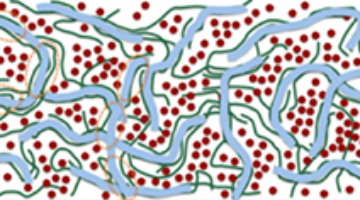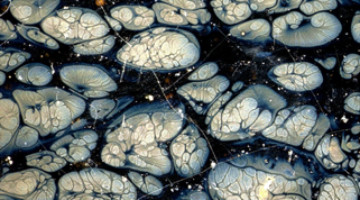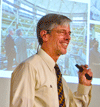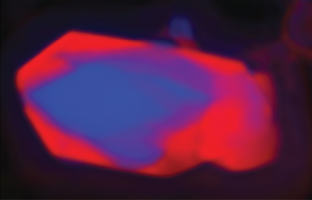Hu et al. designed a new yellow phosphor with high quantum yield by immobilizing a preslected chromophore into the rigid framework of a metal–organic framework (MOF); the structure was determined at Beamline 11.3.1. Coating a blue light-emitting diode (LED) with this compound readily generates white light with high luminous efficacy. The new yellow phosphor demonstrates great potential use in phosphor-converted white LEDs. Read more »
In Situ X-Ray Scattering Helps Optimize Printed Solar Cells
Printable plastic solar cells are a potential source of inexpensive renewable energy, but the transition from lab to factory results in decreased efficiency. Now, for the first time, a miniature solar-cell printer installed in a beamline allows researchers to use x-ray diffraction and scattering to figure out why. Read more »![]()
![]()
The Butterfly Effect on Magnetic Vortices
A recent x-ray microscopy study at ALS Beamline 6.1.2 provided evidence that the ultrafast dynamics preceding magnetic vortex formation exhibits the characteristic chaotic behavior known as the butterfly effect, where minute changes can significantly determine the final outcome of a process.
Antiferromagnetic Spins Do The Twist
At ALS Beamline 4.0.2, researchers have found that the spins in an antiferromagnetic nanolayer perform a version of “The Twist,” turning one way and then the other, challenging a model that has been a cornerstone of exchange-bias theory for 27 years.
Read more »
New Technique Gives a Deeper Look into the Chemistry of Interfaces
A new technique developed at the ALS offers sub-nanometer depth resolution of every chemical element to be found at heterogeneous interfaces, such as those in batteries and fuel cells. The technique has relevance to energy research, heterogeneous catalysis, electrochemistry, and atmospheric and environmental science. Read more »![]()
![]()
Rare Iron Oxide in Ancient Chinese Pottery
New analysis of ancient Jian ware reveals that the distinctive pottery contains an unexpected and highly unusual form of iron oxide. This rare compound was only recently discovered and characterized by scientists and so far has been extremely difficult to create with modern techniques.
Read more »
Brain Receptor Structures Key to Future Therapeutics
Neurotransmitter receptor proteins are critical to learning and memory. Mutations are associated with neurological and neuropsychiatric conditions including Alzheimer’s, epilepsy, and autism. Structures of two such receptors, solved by x-ray crystallography, provide a blueprint for the development of therapeutics. Read more »![]()
![]()
February 4, 2015
Wednesday, February 4 @ 12 noon, USB 15-253 Direct Heat-to-Electricity Conversion Using Thermionics A joint presentation from two new members of Cyclotron Road, Berkeley Lab’s early-stage energy technology incubation program. Daniel Riley Jared Schwede Read more »
ALS Director’s Update: Reflections on our Past, Present, and Future
We are looking forward to an exciting and productive year at the ALS, with plans for new beamlines and capabilities coming online, and more users taking advantage of our technical and scientific expertise to produce a record number publications. At the ALS, we are encouraged by this year’s funding and are looking for new ways to focus on our core strengths while expanding partnerships to explore new opportunities. Read more »
Record-Setting Microscopy Illuminates Energy Storage Materials
Using soft x-ray ptychography, researchers at the ALS have demonstrated the highest-resolution x-ray microscopy ever achieved by imaging five-nanometer structures. The researchers used ptychographic imaging to map the chemical composition of lithium iron phosphate nanocrystals, yielding important new insights into a material of high interest for electrochemical energy storage. Read more »![]()
![]()
- « Previous Page
- 1
- 2
- 3
- 4
- 5
- 6
- …
- 17
- Next Page »






